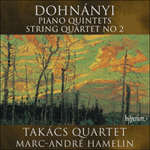
Welcome to Hyperion Records, an independent British classical label devoted to presenting high-quality recordings of music of all styles and from all periods from the twelfth century to the twenty-first.
Hyperion offers both CDs, and downloads in a number of formats. The site is also available in several languages.
Please use the dropdown buttons to set your preferred options, or use the checkbox to accept the defaults.

| Marc-André Hamelin (piano), Takács Quartet» More |
In listening to the Piano Quintet No 1 in C minor, Op 1, it is easy to hear what earned Brahms’s admiration. It is a four-movement work in the great Romantic tradition, showing a mastery of counterpoint and form that far surpasses what one would expect from a student work. The opening allegro movement is a sombre march in sonata form, with expansive melodies and a coda that presents the main theme in C major instead of the C minor in which it was initially presented. The second movement is a lively scherzo, full of the humour that would become a hallmark of Dohnányi’s brilliant compositional style. The ternary-form third movement, marked ‘Adagio, quasi andante’, is evocative of Schumann in the lyrical beauty of its melodies and counter-melodies. The allegro animato finale is a sonata-rondo in a playfully asymmetric 5/4 metre. Near the end of the movement Dohnányi returns to the main theme from the first movement, rendered once more in C major, to bring his first masterwork to a jubilant conclusion.
from notes by James A Grymes © 2019
À l’écoute du Quintette avec piano n° 1 en ut mineur, op.1, il est facile de comprendre ce qui suscita l’admiration de Brahms. C’est une œuvre en quatre mouvements dans la grande tradition romantique, qui montre une maîtrise du contrepoint et de la forme surpassant de loin ce que l’on pourrait attendre de l’œuvre d’un étudiant. Le mouvement initial allegro est une sombre marche en forme sonate, avec de très longues mélodies et une coda qui présente le thème principal en ut majeur au lieu d’ut mineur, tonalité dans laquelle il est initialement exposé. Le deuxième mouvement est un scherzo plein d’entrain, qui regorge de l’humour qui allait devenir la marque de l’écriture brillante de Dohnányi. Le troisième mouvement de forme ternaire, marqué «Adagio, quasi andante», évoque Schumann dans la beauté lyrique de ses mélodies et contrechants. Le finale allegro animato est un rondo de sonate dans la métrique à 5/4 malicieusement asymétrique. Vers la fin de ce mouvement, Dohnányi revient au thème principal du premier mouvement, une fois encore en ut majeur, pour mener son premier chef-d’œuvre à une conclusion débordante de joie.
extrait des notes rédigées par James A Grymes © 2019
Français: Marie-Stella Pâris
Beim Hören des Klavierquintetts Nr. 1 in c-Moll, op. 1, lässt sich leicht nachvollziehen, wie es Brahms’ Bewunderung erlangt hatte. Es handelt sich um ein viersätziges Werk, das sich in die große romantische Tradition einreiht und eine Beherrschung von Form und Kontrapunkt aufweist, die weit über das hinausgeht, was man von dem Werk eines Studenten erwarten würde. Der erste Satz, ein Allegro, ist ein düsterer Marsch in Sonatenform mit ausladenden Melodien und einer Coda, in der das Hauptthema in C-Dur anstelle des ursprünglichen c-Moll erklingt. Der zweite Satz ist ein lebhaftes Scherzo, voller Humor, was ein Markenzeichen für Dohnányis brillanten Kompositionsstil werden sollte. Der dreiteilige dritte Satz ist überschrieben mit „Adagio, quasi andante“ und erinnert mit der lyrischen Schönheit seiner Melodien und Gegenmelodien an Schumann. Das Finale, ein Allegro animato, ist ein Sonatenrondo in einem spielerisch-asymmetrischen 5/4-Metrum. Gegen Ende des Satzes kehrt Dohnányi zu dem Hauptthema des ersten Satzes zurück, wiederum in C-Dur, und bringt damit sein erstes Meisterwerk zu einem jubelnden Abschluss.
aus dem Begleittext von James A Grymes © 2019
Deutsch: Viola Scheffel
 Dohnányi: Piano Quintets & String Quartet No 2 Dohnányi: Piano Quintets & String Quartet No 2The celebrated partnership of Marc-André Hamelin and the Takács Quartet has already set down reference recordings of piano quintets by Schumann, Franck and Shostakovich, and this latest addition is equally illustrious: an important milestone in th ...» More |

